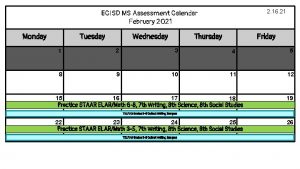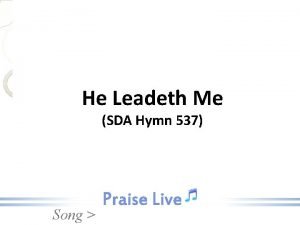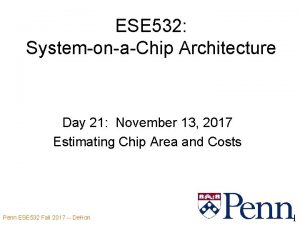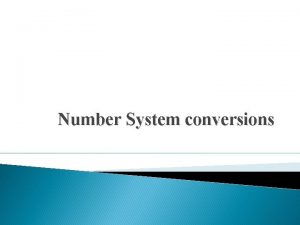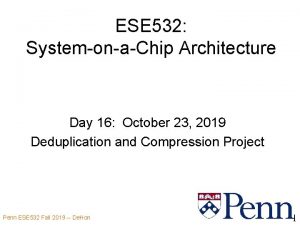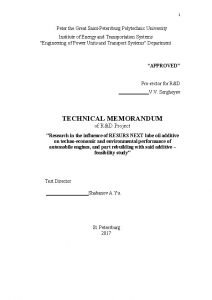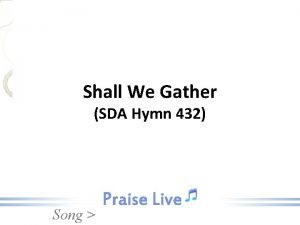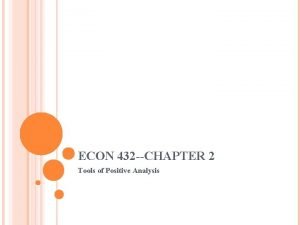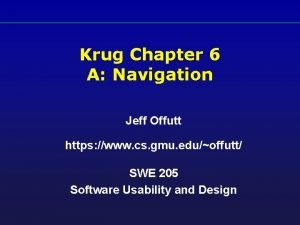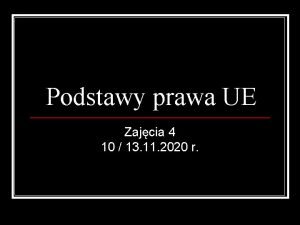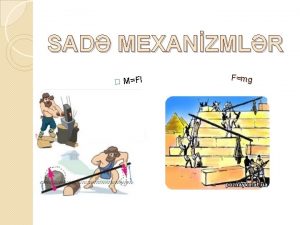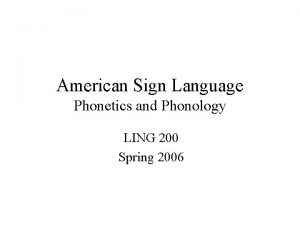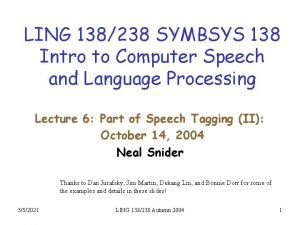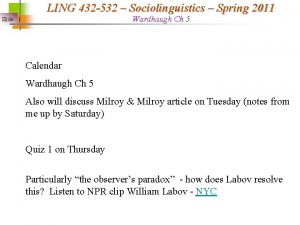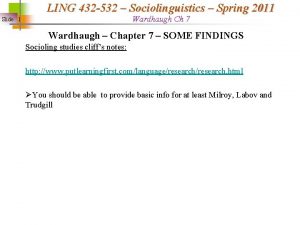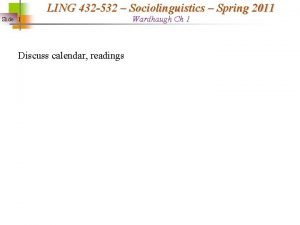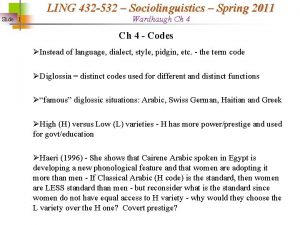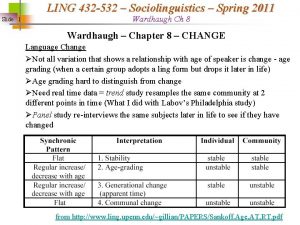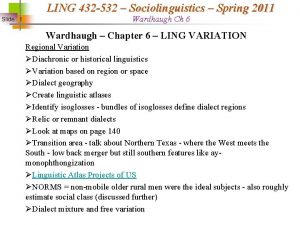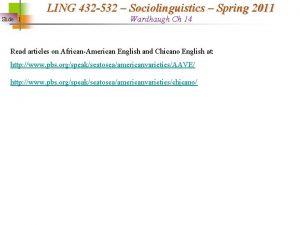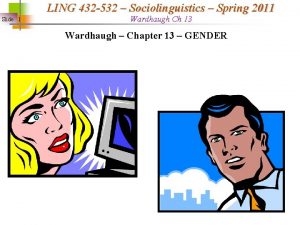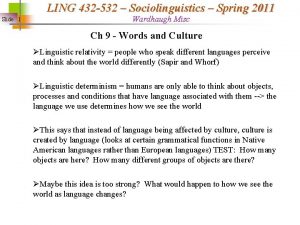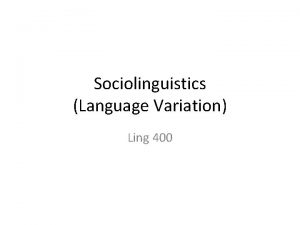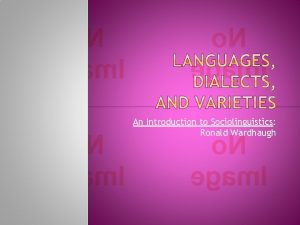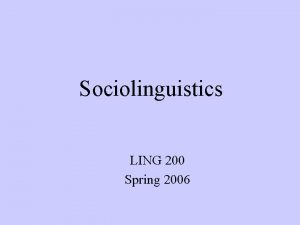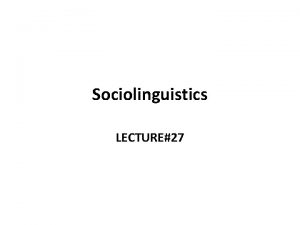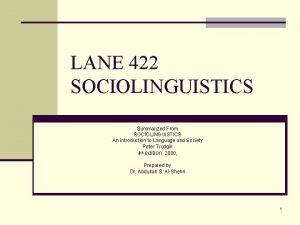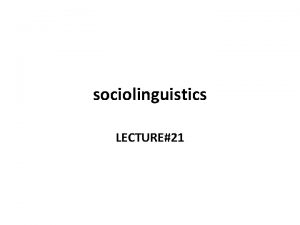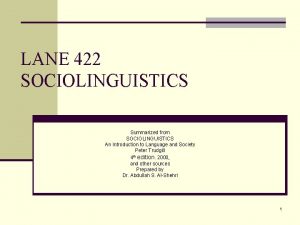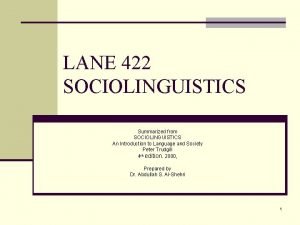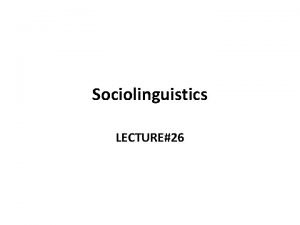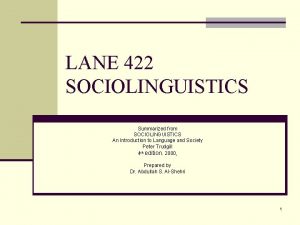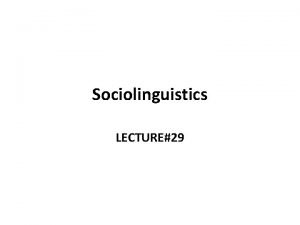LING 432 532 Sociolinguistics Spring 2011 Wardhaugh Ch
































- Slides: 32

LING 432 -532 – Sociolinguistics – Spring 2011 Wardhaugh Ch 2 Slide 1 Small group discussion: Try to characterize your own speech – how is it similar and how is it different than others around you? Be 100% honest – what are your pet peeves with language? What are some things that you hear/see that instigates that “gut reaction” in a negative way?

LING 432 -532 – Sociolinguistics – Spring 2011 Slide 2 Wardhaugh Ch 2 Wardhaugh – Chapter 2 ØWhat is the difference between language and dialect? ØVariety is a term used for to replace both terms - Hudson says “a set of linguistic items with similar distribution” ØVariety is some linguistic shared items which can uniquely be associated with some social items

LING 432 -532 – Sociolinguistics – Spring 2011 Wardhaugh Ch 2 Slide 3 Wardhaugh – Chapter 2 Dialect and accent ØAccent - pronunciation ØDialect - includes pronunciation, but also includes grammatical, lexical and usage - MFL example ØDialects in North America are mutually intelligible - the differences do not impede communication totally ØAnother real example - “No blended drinks today - the blender is broke” at a coffee hut in Portland - where do you think this was? Why?

LING 432 -532 – Sociolinguistics – Spring 2011 Slide 4 Wardhaugh Ch 2 Wardhaugh – Chapter 2 ØWhat is the difference between language and dialect? ØDo you speak a language or a dialect? ØMost speakers can give a name to what they speak - but remember Steve Harvey on DYSA - Q: “Do you speak American? ” A: ”I speak good enough American” ØThere are sometimes very big differences between folk ideas about varieties and linguistic realities - Dennis Preston’s work on Perceptual Dialectology ØOften follows standard versus nonstandard ØBigger difference between grammatical over phonological variables ØLinguistic insecurity - how a speaker of a sub-standard variety feels about his/her variety ØLinguistic security - Are Portlanders insecure or secure about our variety?

LING 432 -532 – Sociolinguistics – Spring 2011 Slide 5 Wardhaugh Ch 2 Wardhaugh – Chapter 2 What are the different regional accents in your opinion?

LING 432 -532 – Sociolinguistics – Spring 2011 Slide 6 Wardhaugh Ch 2 Wardhaugh – Chapter 2 The Oregonian Regarding Jeff Conn's opinions about whether or not Portlanders are developing their own unique dialect Piffle! I've lived in Portland - and other western locations - and here's my take: Intelligently spoken "western speech" that is free of recently introduced speech influences from other regions (i. e. southern, Bostonian, ethnic, etc. ) is the purest and most accent free English in the whole world. If you doubt me, go to England converse with normal, everyday folks. Most have terrible pronunciation. Many of them are borderline unintelligible. London east-ender "Cockney" is totally indecipherable! Then go north to Scotland. Delightful people, but what they speak sounds nothing like what the dictionary pronunciation guide says it should sound like. Same thing in Ireland, and Australia. Lovely people. Terrible speech habits. But back to the U. S. There are too many people moving from other regions into our western stronghold to justify calling any bad speech habits as being anything but temporary. By far the biggest influence on Pacific Northwest speech is the same as with other western regions - and probably other parts of the country; namely, teenagers develop their own subnormal vocabulary and way of speaking. Although much more extreme than with previous generations, subnormal has always been associated with teenagers. The big difference now is that when young people eventually mature, they don't drop their language in favor of adult speech. Our adult language has become the prisoner of "teenspeak, " and that is an utter abomination. True, languages evolve; but adults copying the speech of rebellious anti-social youth is not the hallmark of a great society. And this decline of the American language will probably continue indefinitely; when was the last time you heard a teenager say "It's time for me to speak good, correct English? " Like, man, it'll never happen. "'S'up? " "He goes, " "She goes. " Our language is dying, but it had a pretty good run. Luckily for me, most of my life has been during the good part.

LING 432 -532 – Sociolinguistics – Spring 2011 Slide 7 Wardhaugh Ch 2 Wardhaugh – Chapter 2 ØWhat is the difference between language and dialect? ØThere a lot of situations that show language versus dialect isn’t clear ØChinese ØNorwegian/Swedish ØCroatian and Serbian ØHebrew ØArabic ØSpanish?

LING 432 -532 – Sociolinguistics – Spring 2011 Slide 8 Wardhaugh Ch 2 Wardhaugh – Chapter 2 ØWhat is the difference between language and dialect? ØNeed to discuss issues of solidarity and power - How do these play into the definitions of a variety as a dialect or language? Ø“A language is a dialect with an army and a navy”

LING 432 -532 – Sociolinguistics – Spring 2011 Slide 9 Wardhaugh Ch 2 Wardhaugh – Chapter 2 ØBell’s criteria for the difference between language and dialect? ØSTANDARDIZATION - has the language been codified? Written tradition, grammar and spelling books, dictionaries, literature. ØMore than just linguistic - includes economic, social, political ØSelection of norms ØStandard English still tough to define because no agreed upon norms ØWill text messaging (a written form of the English language that is becoming codified) influence Standard English norms? thru - other alternate spellings? ØDifference between standard grammar and pronunciation ØNegative concord - I don’t wanna be lonely no more ØSolidarity away from the standard (covert prestige rather than overt prestige) ØWhy would you NOT want to use Standard English - small group discussions

LING 432 -532 – Sociolinguistics – Spring 2011 Slide 10 Wardhaugh Ch 2 Wardhaugh – Chapter 2 ØBell’s criteria for the difference between language and dialect? ØVITALITY - Living versus dead languages - Hebrew/Irish Gaelic ØHISTORICITY - a language of identity - belongs to its speakers - Germany and German language - Chinese ØAUTONOMY - a language is felt to be different by its speakers - Catalan? problems with pidgin and creole langs - Chinese again ØREDUCTION - functionally limited, particularly to less prestigious domains linguistic insecurity - pidgins

LING 432 -532 – Sociolinguistics – Spring 2011 Slide 11 Wardhaugh Ch 2 Wardhaugh – Chapter 2 ØBell’s criteria for the difference between language and dialect? ØMIXTURE - speakers’ feelings about the purity of the language they speak ØDE FACTO NORMS - ‘good’ and ‘bad’ speakers and that there is a proper way of speaking - used and actual norms ØAs professors, we used to use overheads, but anymore we just use powerpoint. ØThis didn’t use to be Gresham, but anymore it is. ØI don’t eat carbs anymore. ØSo many people are on an all-protein diet anymore. ØWith these criteria, different varieties meet them differently

LING 432 -532 – Sociolinguistics – Spring 2011 Slide 12 Wardhaugh Ch 2 Wardhaugh – Chapter 2 Regional Dialects ØDialect - has some tradition of writing in the variety (Mark Twain) ØPatois - usually a very pejorative term for a variety that is less than a dialect rural speech -

LING 432 -532 – Sociolinguistics – Spring 2011 Slide 13 Wardhaugh Ch 2 Wardhaugh – Chapter 2 Regional Dialects ØDialect continuum - one definition of dialect is a mutually intelligible variety of a language. A continuum exists in geography if you travel from NW France to SE Italy or SW Spain - all related languages. Each adjacent village can understand each other regardless of where the political borders are. BUT Paris, Madrid and Rome speak varieties that are not mutually intelligible, therefore separate languages

LING 432 -532 – Sociolinguistics – Spring 2011 Slide 14 Wardhaugh Ch 2 Wardhaugh – Chapter 2 Regional Dialects ØDialect Geography - mapping regional dialects through the use of isoglosses ØRP, Estuary English, General American ØRegional varieties described in terms of lexical choices done through Linguistic Atlas creation - http: //us. english. uga. edu/ ØDialectologists looked at NORMs - old men in the sticks! = non-mobile older rural males ØAsked what is the word you use for. . . ØPlotted variation on a map and drew lines - isoglosses ØNow sociolinguists look at urban populations and exam different regions in terms of what is happening in the cities and in terms of language change

LING 432 -532 – Sociolinguistics – Spring 2011 Wardhaugh Ch 2 Slide 15 Wardhaugh – Chapter 2 Regional Dialects - Isogloss

LING 432 -532 – Sociolinguistics – Spring 2011 Slide 16 Wardhaugh Ch 2 Wardhaugh – Chapter 2 One variable isogloss – cot vs. caught = low back merger

LING 432 -532 – Sociolinguistics – Spring 2011 Slide 17 Wardhaugh Ch 2 Wardhaugh – Chapter 2 Regional Dialects of American English

LING 432 -532 – Sociolinguistics – Spring 2011 Slide 18 Wardhaugh Ch 2 Wardhaugh – Chapter 2 Regional Dialects of American English http: //aschmann. net/Am. Eng/

LING 432 -532 – Sociolinguistics – Spring 2011 Slide 19 Wardhaugh Ch 2 Wardhaugh – Chapter 2 Carver’s dialect map broken up into smaller dialects

LING 432 -532 – Sociolinguistics – Spring 2011 Slide 20 Carver’s hierarchy Wardhaugh Ch 2

LING 432 -532 – Sociolinguistics – Spring 2011 Slide 21 Wardhaugh Ch 2 Wardhaugh – Chapter 2 Regional Dialects of American English

LING 432 -532 – Sociolinguistics – Spring 2011 Slide 22 Wardhaugh Ch 2 Wardhaugh – Chapter 2 Regional Dialects of American English - defined by language changes in vowel systems ØNorthern Cities Shift (play Chicago sample - 3 mins)

LING 432 -532 – Sociolinguistics – Spring 2011 Slide 23 Wardhaugh Ch 2 Wardhaugh – Chapter 2 Regional Dialects of American English - defined by language changes in vowel systems ØNorthern Cities Shift (play Chicago sample - 3 mins)

LING 432 -532 – Sociolinguistics – Spring 2011 Slide 24 Wardhaugh Ch 2 Wardhaugh – Chapter 2 Regional Dialects of American English - defined by language changes in vowel systems ØThe Southern Shift (Play Arkansas 2 mins; play Eng 3 mins; ØTrace Adkins - country music

LING 432 -532 – Sociolinguistics – Spring 2011 Slide 25 Wardhaugh Ch 2 Wardhaugh – Chapter 2 Regional Dialects of American English - defined by language changes in vowel systems ØThe Southern Shift (Play Arkansas 2 mins; play Eng 3 mins; ØTrace Adkins - country music

LING 432 -532 – Sociolinguistics – Spring 2011 Wardhaugh Ch 2 Slide 26 Wardhaugh – Chapter 2 Regional Dialects of American English - defined by language changes in vowel systems ØThe California/Canada Shift (Play Cali - 1: 45; Ontario 2: 15) ØFrank Zappa’s Valley girl

LING 432 -532 – Sociolinguistics – Spring 2011 Slide 27 Wardhaugh Ch 2 Sociolinguistics Linguistic variation and change ØThe California/Canada Shift (Play Cali - 1: 45; Ontario 2: 15)

LING 432 -532 – Sociolinguistics – Spring 2011 Wardhaugh Ch 2 Slide 28 Wardhaugh – Chapter 2 Social Dialects ØVarieties based on social groupings other than region ØWhat social categories do you think are important? ØClass ØEthnicity ØAge ØSex/Gender

LING 432 -532 – Sociolinguistics – Spring 2011 Slide 29 Wardhaugh Ch 2 Wardhaugh – Chapter 2 Styles, Registers and Beliefs ØStyle = formal versus informal - intraspeaker variation ØRegister = sets of items associated with discrete occupational or social groups ØRural dialects sometimes better than urban ones ØConnection between older forms (often found in more formal speech) ØIdeas of correctness - judgments passed on those who use “incorrect” forms ØLeads to many myths about language - Preston again - accentless English (remember the emailer from Portland? ) ØWhat happens when style and these ideas of correctness come into contact with linguistic insecurity?

LING 432 -532 – Sociolinguistics – Spring 2011 Slide 30 Wardhaugh Ch 2 Wardhaugh – Chapter 2 Labov’s study of NYC shows that social class, attention to speech influence a linguistic variable (r) in systematic ways - shows hypercorrection

LING 432 -532 – Sociolinguistics – Spring 2011 Slide 31 Wardhaugh Ch 2 Wardhaugh – Chapter 2 Styles, Registers and Beliefs ØSome researchers (Eckert and her followers) believe that by examining intraspeaker variation, we can see how sociolinguistic variables are USED to create various identities in various settings ØThis promotes the idea that you create who you are through the use of sociolinguistic variation

LING 432 -532 – Sociolinguistics – Spring 2011 Slide 32 Wardhaugh Ch 2 Language Attitudes - Project 1 (Dialect) Read the Language Myth by Dennis Preston at: http: //www. pbs. org/speak/speech/prejudice/attitudes/
 Hakikat atau pengertian bahasa;
Hakikat atau pengertian bahasa; Ecisd spring break 2011
Ecisd spring break 2011 Winter summer spring autumn
Winter summer spring autumn Spring summer fall winter and spring cast
Spring summer fall winter and spring cast Ese 532
Ese 532 Sda hymn 532
Sda hymn 532 Ese 532
Ese 532 Ese 532
Ese 532 Ese 532
Ese 532 Ese 532
Ese 532 Number system
Number system Ese 532
Ese 532 Ese 532
Ese 532 532
532 Ese 532
Ese 532 +1 (432) 498-0251
+1 (432) 498-0251 Sda hymn 432
Sda hymn 432 Impossible 13
Impossible 13 Define positive analysis
Define positive analysis 432 in minutes
432 in minutes Swe 432
Swe 432 Swe 432 gmu
Swe 432 gmu C-432/04
C-432/04 Ertugrul 432
Ertugrul 432 Swe 432
Swe 432 Mexel 432
Mexel 432 N 432
N 432 Eisa 432
Eisa 432 Tərpənməz blok
Tərpənməz blok Ling oa
Ling oa Ling 200
Ling 200 Cheung yin ling
Cheung yin ling Ling
Ling

